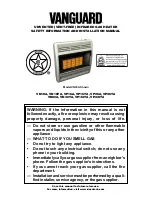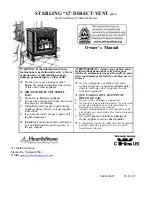
H I G H P R E S S U R E P O R T A B L E F O R C E D A I R H E A T E R S E R V I C E M A N U A L
21
TROUBLESHOOTING — PROBLEM CONDITIONS
OBSERVED PROBLEM
Heater does not start. Motor and transformer do not operate
.
POSSIBLE CAUSES
A. Blown fuse or tripped circuit breaker
B. Frayed or broken wires on extension
cord
C. Flame control tripped
D. Defective thermostat
E. Defective fan switch
F. Defective flame control
TEST PROCEDURES
A. Blown fuse or tripped circuit breaker
Check for blown fuse or tripped circuit breaker
at electrical supply. Correct if needed.
B. Frayed or broken wires on
extension cord
Check for frayed or broken wires. Replace
cord if highly worn, cut, or broken.
C. Flame control tripped
The heater is equipped with one of two flame
controls.
1. White-Rogers/Robert Shaw flame control
2. Standard flame control
Figure 31 - Standard Flame Control
RESET
Figure 30 - White-Rogers/Robert Shaw
Flame Control
The White-Rogers/Robert Shaw flame con-
trol is large and square. It is mounted beside
the motor on the wiring cover plate. It is either
black or grey in color with the reset button
located on top. The standard flame control is
much smaller than the White-Rogers/Robert
Shaw flame control. It is located beside the
motor and covered by the wiring cover plate.
The reset button is located on the side of the
motor support.
Depress reset button on flame control. This
will reset the flame control for proper opera-
tion.
D.
Defective thermostat
1. Unplug heater.
2. Remove outer cover of thermostat. Do
this by removing the set screw on ther-
mostat cover.
Note: Newer thermostats
require you to remove thermostat knob
before removing cover.
3. Set ohmmeter on the RX1 position.
4. Connect test leads of ohmmeter to two
screw terminals inside thermostat.
5. Turn thermostat knob to a temperature
setting that is higher than room tempera-
ture. Ohmmeter should read continuity (0
ohms).
6. Turn thermostat knob to a temperature
setting that is lower than room tempera-
ture. Ohmmeter should show an open
circuit.
7. Replace thermostat if any of these condi-
tions are not met during testing.
E. Defective fan switch
Follow steps under DEFECTIVE FAN
SWITCH, procedure “D” on page 20.
F. Defective flame control
Follow steps under DEFECTIVE FLAME
CONTROL, procedure “A” on page 18.




































